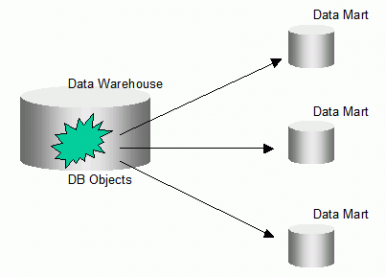Databases have become something more than just structured tables for storing and retrieving information in singular applications; integrated Big Data analytics tools transform databases into new analytical platforms. The architecture is evolving and growing rapidly in response to the need to deliver insightful business intelligence to decision makers and data scientists.
Data Storage Structures For Big Data
The architecture for data wrangling in Big Data applications is essentially the opposite of the traditional siloes of discrete data sets of legacy software systems that now integrate as one set across the entire organization. The new forms, which are still evolving, have names that indicate their functionalities, like warehouses, lakes, and swamps.
So, let's define a difference between these Big Data terms.
Data Warehouse
A Data Warehouse brings the database directly into enterprise analytics. The data warehouse is the structured repository designed to encompass all of the data resources of an organization, from which the system draws the data to process it and deliver it to users. This type of system stores the data more loosely; holding different structures and sources in a common framework, it feeds data directly to processing and analysis layers and data marts.

Data Mart
A Data Mart is the staging area for data that serves the needs of a particular segment or business unit. It is a subset of the data in the data warehouse that focuses the information to a particular subject or operational department, fitted to the purpose of the users without redundancy.

Data Lake
Data warehousing applies the structure on the way in, organizing it to fit the context of the database schema. Data lakes facilitate a much more fluid approach; they only add structures to data as it dispenses to the application layer. In storage, data lakes preserve the original structures or unstructured forms to remain; it is a Big Data storage and retrieval system that could conceivably scale upward indefinitely.

source: kdnuggets.com
Data Swamp
Data lakes do not require much structure, and they accept all data. However, in poorly designed and neglected systems, they risk becoming data swamps. A Data Swamp is the term that describes the failure to document the stored data accurately, resulting in the inability to analyze and exploit the data efficiently; the original data may remain, but the data swamp cannot retrieve it without the metadata that gives it context.

source: martinfowler.com
Data Cube
A Data Cube is an application that puts data into matrices of three or more dimensions. Transformations in the data express as tables, arrays of processed information. Where tables match rows of data strings with columns of data types, a data cube cross-references tables from single or multiple data sources to increase the detail associated with each data point. This transformation connects the data to a position in rows and columns of more than one table. The benefit is that knowledge workers can use data cubes to create data volumes to drill down into and discover the deepest insights possible.
Conclusions
The result of integrating databases with Big Data is that information systems are much more versatile and flexible. The new architectures for data allow developers and data scientists to create information systems that serve the purposes of all users. Data warehouses, data lakes, and data cubes are tools that channel data insights and deliver business intelligence in the forms that users need, providing business growth that mirrors the potential as the technology continues to develop.






